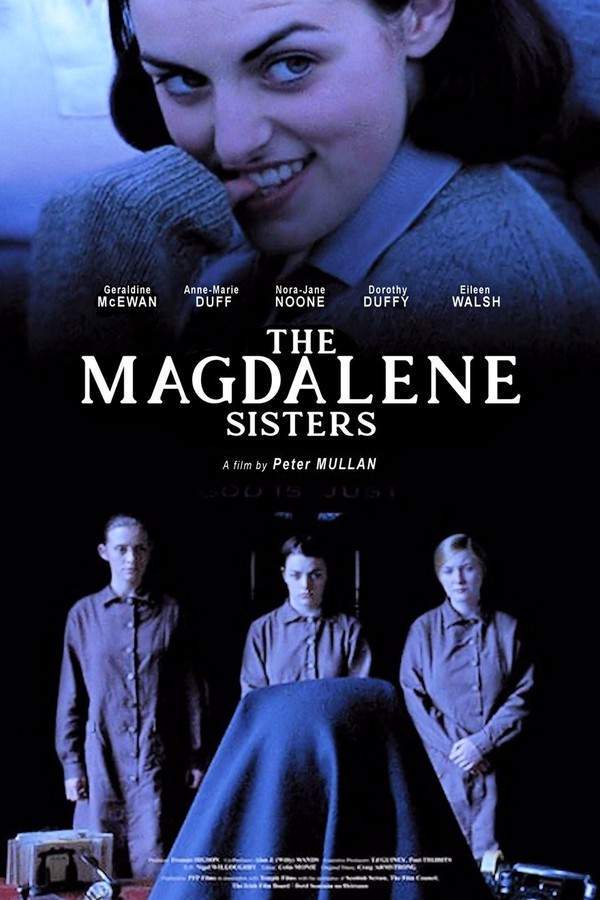
The Magdalene Sisters 2003
Directed by

Peter Mullan
Made by

Miramax Films
The Magdalene Sisters Plot Summary
Read the complete plot summary and ending explained for The Magdalene Sisters (2003). From turning points to emotional moments, uncover what really happened and why it matters.
In 1964 Ireland, women deemed “fallen” are viewed as needing redemption. The story follows the harrowing experiences of four young women: Margaret, who suffers from the trauma of being raped by her cousin; Bernadette, whose striking beauty and flirtatious nature lead to her family’s shame; Rose, an unmarried mother; and Crispina, an intellectually challenged unmarried mother. These women find themselves forcefully confined to a Magdalene asylum by their families and caretakers.
The film starkly reveals the dismal lives these girls endure as inmates, focusing on their cruel daily routines and deplorable conditions in the laundries. The Mother Superior, a figure of terrifying authority, oversees their punishment with brutal fervor. Sister Bridget, played by Eileen Walsh, presents a façade of gentleness, but her cruelty is indisputable. Her sadistic tendencies manifest in harrowing scenes, such as her merciless beating of Rose (also played by Anne-Marie Duff), visible to Bernadette. In another shocking instance, after Una attempts to escape, Sister Bridget cruelly mocks her by shaving her head while laughing at her despair.
The financial exploitation of the asylum system is evident, with Sister Bridget delighting in the revenue generated for the institution, while the women, likened to Mary Magdalene, endure deprivations that include inadequate meals—Sister Bridget enjoys opulent breakfasts while the inmates are left with meager oatmeal. An especially dehumanizing scene showcases the women forced to stand naked after communal showers as the nuns subject them to a grotesque “contest” based on their physical attributes.
The presence of Father Fitzroy, a corrupt priest, amplifies the tragedy, as he sexually abuses Crispina. As time goes on, modernization creeps in with automatic washing machines, heralding the decline of commercial laundries and the eventual unsustainability of the Magdalene institutions.
Amidst the gloom, three girls exhibit resilience against their circumstances. After Margaret is allowed to leave thanks to her younger brother’s intervention, she defiantly confronts Sister Bridget, only to fall to her knees in prayer when rebuffed. The surprise of the Mother Superior allows her to pass, highlighting her quiet strength. Meanwhile, Bernadette and Rose come together in a bold escape attempt, wrecking Sister Bridget’s office in their quest for freedom. With a mix of suspense and determination, they manage to evade her and receive aid from a compassionate relative. The film concludes on a hopeful note as Rose boards a coach to Liverpool and Bernadette pursues her dream of becoming a hairdresser.
In stark contrast, Crispina’s fate is tragic; voiceless due to the abuse she suffered, she spends her life in a mental institution and ultimately succumbs to anorexia at the tender age of 24. Although the script is fictionalized, it draws inspiration from real-life testimony, as captured in the documentary Sex in a Cold Climate, shedding light on the grueling realities faced by these women.
The Magdalene Sisters Timeline
Follow the complete movie timeline of The Magdalene Sisters (2003) with every major event in chronological order. Great for understanding complex plots and story progression.
Introduction of the Magdalene Asylum
In 1964 Ireland, women deemed 'fallen' are sent to Magdalene asylums for redemption. These facilities are run by the Church and operate under the guise of moral rehabilitation for women who have faced societal judgment.
Meet the Inmates
The story focuses on four young women: Margaret, who is traumatized after being raped; Bernadette, whose beauty brings shame to her family; Rose, an unmarried mother; and Crispina, who is intellectually challenged and also an unmarried mother. Each character's backstory is a testament to their struggles in a society that harshly judges women.
Cruel Daily Routines
The inmates endure brutal daily routines governed by the Mother Superior and the sisters. Their lives are marked by harsh punishments and incredibly deplorable conditions, emphasizing the systemic cruelty within the asylum.
Sister Bridget's Authority
Sister Bridget, the overseer of the asylum, presents herself as gentle but displays cruelty to the inmates. Her sadistic tendencies come to light when she harshly punishes Rose, humiliating her in front of the other women.
Una's Escape Attempt
Una, one of the inmates, musters the courage to try and escape from the asylum. However, her ill-fated attempt leads to her being punished in a gruesome way, as Sister Bridget shaves her head while mocking her desperation.
Financial Exploitation Revealed
The film reveals the financial exploitation within the Magdalene institutions, where the revenue generated by the women's labor is enjoyed by the sisters. While Sister Bridget indulges in lavish meals, the inmates suffer from inadequate nourishment.
Dehumanizing Experiences
The women face dehumanizing treatments, such as being forced to stand naked after communal showers. This grotesque practice underscores the complete loss of dignity endured by the women in the asylum.
Father Fitzroy's Abuse
The tragedy deepens with the presence of Father Fitzroy, a corrupt priest who exploits his position to sexually abuse Crispina. This adds a layer of horror to the already bleak existence of the women in the asylum.
Mysteries of Modernization
As advancements like automatic washing machines emerge, the sustainability of the Magdalene institutions comes into question. This modernization signals a shift that threatens the very foundation of the oppressive system in place.
Margaret's Confrontation
Margaret eventually finds a way to leave the asylum thanks to her younger brother's intervention. In a defiant moment, she confronts Sister Bridget, revealing her inner strength despite the harrowing circumstances.
Escape Attempt by Bernadette and Rose
Bernadette and Rose band together to orchestrate a desperate escape from the asylum. Their plan involves wrecking Sister Bridget’s office, showcasing their resolve and desire for freedom amidst the oppressive environment.
Finding Help
After their escape attempt, the two women receive aid from a compassionate relative who recognizes their plight. This act of kindness offers a glimmer of hope in the midst of their suffering.
Rose's Departure
The film concludes with Rose boarding a coach to Liverpool, symbolizing a new beginning. Her journey signifies resilience and hope as she leaves the painful memories of the asylum behind.
Bernadette's Dreams
Following her escape, Bernadette pursues her long-held dream of becoming a hairdresser. This step represents her desire for independence and a brighter future away from the confines of the asylum.
Crispina's Tragic Fate
In stark contrast to her friends, Crispina's story ends tragically as she is unable to escape the trauma she endured. She eventually succumbs to anorexia, lost forever in a mental institution, highlighting the devastating consequences of abuse.
The Magdalene Sisters Characters
Explore all characters from The Magdalene Sisters (2003). Get detailed profiles with their roles, arcs, and key relationships explained.
Rose (Anne-Marie Duff)
Rose is portrayed as a strong-willed and compassionate character who embodies the struggles faced by many women in the asylum. Despite enduring extreme hardships, she shows a remarkable capacity for hope and defiance. Her journey reflects the desire for freedom and a better life beyond the oppressive environment of the asylum.
Sister Bridget (Eileen Walsh)
Sister Bridget is a complex antagonist whose façade of gentleness masks her cruelty. As the enforcer of the institution's harsh rules, she embodies the sadistic aspects of authority in the asylum. Her character reveals the moral corruption within the system, serving as a chilling portrayal of abuse of power.
Crispina
Crispina's character represents the most tragic outcome of the abuses faced in the asylum. Her vulnerability and suffering at the hands of authority highlight the deeply entrenched injustices women faced. Ultimately, her struggles serve as a heart-wrenching reminder of the consequences of societal neglect and abuse.
Margaret
Margaret’s character grapples with the trauma of her past while trying to navigate life in the asylum. Her emotional depth adds nuance to the story, as she experiences both despair and moments of strength. Her journey towards reclaiming her agency is central to the narrative.
The Magdalene Sisters Settings
Learn where and when The Magdalene Sisters (2003) takes place. Explore the film’s settings, era, and how they shape the narrative.
Time period
1964
The film takes place in 1964, a time when women faced immense societal pressure to conform to strict moral standards. Issues such as women's rights and sexual abuse were often swept under the rug, leading to tragic circumstances for those who deviated from these norms. The narrative reflects the darker sides of this era, exposing the oppression experienced by women in institutions like the Magdalene Asylum.
Location
Ireland, Magdalene Asylum
The movie is set in 1964 Ireland, where societal norms dictate harsh judgments on women labeled as 'fallen'. The Magdalene Asylum is depicted as a grim institution where the women endure severe conditions under the authority of the nuns, far removed from the caring environment one would expect. This setting highlights the cultural stigma and the dire consequences faced by women during this time.
The Magdalene Sisters Themes
Discover the main themes in The Magdalene Sisters (2003). Analyze the deeper meanings, emotional layers, and social commentary behind the film.
💔
Trauma
The film intimately explores themes of trauma, particularly through the experiences of women who suffer from abuse and societal rejection. Margaret's struggle with the aftermath of her rape exemplifies the long-lasting scars that such events leave. Each character's experience is a powerful reminder of the impact of trauma on identity and self-worth.
⚖️
Injustice
Injustice is a prevailing theme throughout the film, as it portrays the brutal realities faced by women confined in the Magdalene Asylum. The characters endure not only physical punishment but also emotional manipulation, illustrating a systemic failure to protect the vulnerable. The film sheds light on the complex dynamics of power and oppression, reflecting broader societal issues.
🌈
Resilience
Amidst the painful environment, themes of resilience emerge as the characters fight against their oppressive circumstances. Margaret, Bernadette, and Rose's attempts to escape represent the indomitable spirit of women seeking freedom and self-determination. Their journey from victimhood to empowerment is a poignant reminder of the strength that can emerge in the face of adversity.
Featured on this page

What's After the Movie?
Not sure whether to stay after the credits? Find out!
Explore Our Movie Platform
New Movie Releases (2025)
Famous Movie Actors
Top Film Production Studios
Movie Plot Summaries & Endings
Major Movie Awards & Winners
Best Concert Films & Music Documentaries
© 2025 What's After the Movie. All rights reserved.




